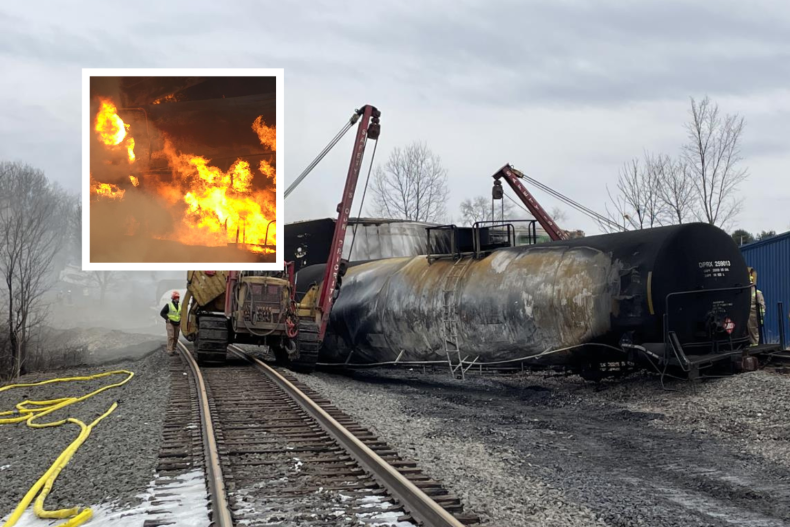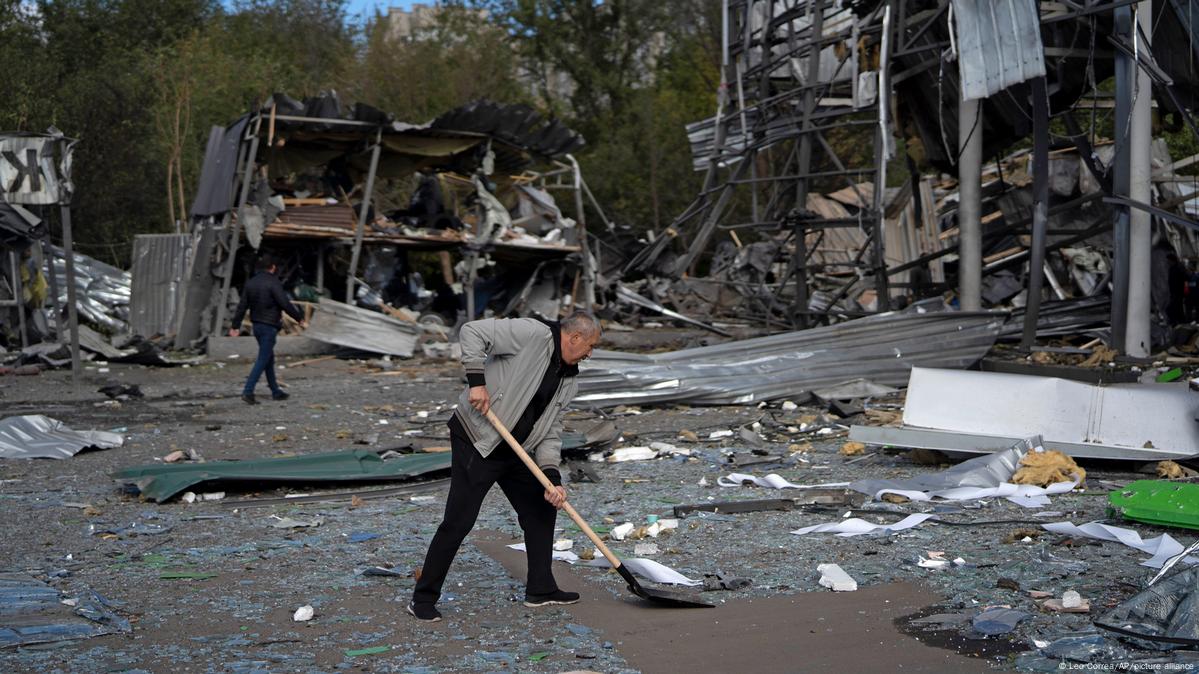Ohio Derailment: Long-Term Impact Of Toxic Chemical Contamination On Buildings

Table of Contents
Types of Chemical Contamination and Their Impact on Buildings
The Ohio derailment released a cocktail of hazardous materials, posing significant threats to the structural integrity and habitability of nearby buildings. Understanding the specific chemicals and their properties is crucial for effective remediation.
Vinyl Chloride's Effects
Vinyl chloride, a known carcinogen, is particularly concerning. Its volatile nature means it can easily leach into building materials like plastics, rubber, and paint, causing degradation over time. Furthermore, vinyl chloride off-gassing can create a hazardous indoor environment, leading to long-term health risks for occupants.
- Leaching into building materials: Vinyl chloride can penetrate porous materials, contaminating them and potentially releasing the chemical over an extended period.
- Off-gassing: Even after the initial release, vinyl chloride can continue to emanate from contaminated materials, creating a persistent indoor air quality problem.
- Long-term health concerns: Exposure to vinyl chloride is linked to various cancers and other serious health issues. Long-term exposure within contaminated buildings poses a significant health risk.
- Need for professional testing: Determining the extent of vinyl chloride contamination requires professional environmental testing to ensure accurate assessment and remediation planning.
Butyl Acrylate and Other Chemicals
Butyl acrylate, another chemical released in the derailment, also presents risks. While its impact may differ from vinyl chloride, it can interact with various building materials, potentially causing structural weakening or discoloration. The presence of other hazardous materials further complicates the situation, necessitating a thorough assessment of the overall contamination.
- Interaction with different materials: Butyl acrylate and other chemicals can react differently with various building materials, requiring specialized remediation strategies depending on the specific materials affected.
- Potential for structural weakening: Depending on the concentration and exposure time, some chemicals may compromise the structural integrity of buildings, necessitating repairs or even demolition.
- Need for specialized remediation techniques: The cleanup process for butyl acrylate and other chemicals may require specialized techniques and equipment to ensure complete removal and prevent further damage.
Assessing the Extent of Contamination
Accurate assessment of the extent of contamination is paramount. Professional environmental testing is crucial to identify the types and levels of chemicals present in buildings. This involves various methods:
- Air quality testing: Measuring the concentration of volatile organic compounds (VOCs) in the air within buildings is essential to determine the level of airborne contamination.
- Surface sampling: Testing building surfaces for chemical residues helps determine the extent of contamination and informs remediation strategies.
- Material analysis: Analyzing building materials (e.g., paint, insulation) for chemical penetration is crucial for identifying the scope of the problem and determining the need for material replacement.
- Importance of certified professionals: It's crucial to use certified environmental professionals with experience in handling hazardous materials for accurate and reliable testing results.
Remediation and Cleanup Strategies for Contaminated Buildings
Remediating buildings affected by the Ohio derailment requires a multifaceted approach. The complexity of the contamination necessitates careful planning and execution.
Decontamination Procedures
Decontamination involves removing toxic chemicals from building surfaces and interiors. This often includes:
- Surface cleaning and disinfection: Using specialized cleaning agents and equipment to remove chemical residues from surfaces.
- Air scrubbing and filtration: Employing air purifiers and filtration systems to remove airborne contaminants and improve indoor air quality.
- Removal of contaminated materials: In cases of severe contamination, the removal and proper disposal of contaminated materials (e.g., drywall, insulation) may be necessary.
- Disposal of hazardous waste: All contaminated materials must be disposed of according to stringent environmental regulations to prevent further spread of contamination.
Structural Repairs and Replacement
In cases of significant structural damage caused by chemical exposure, repairs or even complete demolition and rebuilding might be required.
- Cost of remediation: The financial burden of remediation can be substantial, depending on the extent of damage and the required cleanup methods.
- Insurance coverage: Property owners should explore their insurance coverage for environmental damage and potential reimbursement for remediation costs.
- Potential for government assistance: Government assistance programs may be available to help property owners cover the expenses of remediation.
- Long-term monitoring: Even after remediation, long-term monitoring is essential to ensure the safety and structural integrity of the buildings.
Long-Term Monitoring and Maintenance
Ongoing monitoring is crucial to ensure the long-term safety of the buildings. This includes:
- Air quality monitoring: Regular air quality checks help detect any resurgence of contamination.
- Material integrity checks: Periodic inspections of building materials help assess their condition and identify potential degradation.
- Regular inspections: Regular inspections by qualified professionals are vital for early detection of any problems.
- Ongoing assessment of health risks: Continuous monitoring of potential health risks associated with residual contamination is essential to protect occupants.
Legal and Financial Implications for Property Owners
The Ohio derailment’s impact extends beyond physical damage, creating significant legal and financial challenges for property owners.
Insurance Claims and Legal Recourse
Property owners affected by the derailment should explore their legal options and insurance coverage.
- Insurance coverage for environmental damage: Reviewing insurance policies to determine the extent of coverage for environmental damage caused by the derailment is a crucial first step.
- Legal representation: Seeking legal counsel is recommended to navigate the complexities of insurance claims and potential legal action against responsible parties.
- Class-action lawsuits: Joining class-action lawsuits may provide a pathway for collective legal action and increased leverage.
- Government assistance programs: Exploring government assistance programs designed to help individuals and businesses impacted by environmental disasters.
Financial Burden of Remediation
The cost of remediation can be substantial, placing a heavy financial burden on property owners.
- Remediation costs: The expenses involved in testing, cleaning, repair, or rebuilding can be significant.
- Lost rental income: If buildings are uninhabitable during remediation, property owners may experience loss of rental income.
- Property devaluation: Contamination can lead to a decrease in property value, impacting resale or refinancing options.
- Financial assistance programs: Investigating federal, state, and local financial assistance programs designed to alleviate the financial burden on affected property owners.
Conclusion
The Ohio train derailment presents significant long-term challenges regarding the impact of toxic chemical contamination on buildings in the affected area. Thorough testing, comprehensive remediation strategies, and long-term monitoring are crucial to mitigate health risks and address the substantial financial burden faced by property owners. Understanding the long-term impact of Ohio derailment toxic chemical contamination on buildings is critical for affected residents and property owners. Seek professional assessment and remediation services to ensure the safety and value of your property. Learn more about available resources and legal options regarding the Ohio derailment's impact on your building.

Featured Posts
-
 Ovechkins 893rd Goal One Away From Tyin Gretzky Two From Breaking The Nhl Record
May 16, 2025
Ovechkins 893rd Goal One Away From Tyin Gretzky Two From Breaking The Nhl Record
May 16, 2025 -
 Dodgers Report Minor League Inf Hyeseong Kim Promoted
May 16, 2025
Dodgers Report Minor League Inf Hyeseong Kim Promoted
May 16, 2025 -
 Ataka Na Ukrainu Podrobnosti Massirovannogo Obstrela Bolee 200 Raket I Dronov
May 16, 2025
Ataka Na Ukrainu Podrobnosti Massirovannogo Obstrela Bolee 200 Raket I Dronov
May 16, 2025 -
 21 Jeux Video Rejoignent Ge Force Now En Mois
May 16, 2025
21 Jeux Video Rejoignent Ge Force Now En Mois
May 16, 2025 -
 Haly Wwd Astar Tam Krwz Awr Mdah Ka Jwtwn Ka Waqeh Mkml Tfsylat
May 16, 2025
Haly Wwd Astar Tam Krwz Awr Mdah Ka Jwtwn Ka Waqeh Mkml Tfsylat
May 16, 2025
